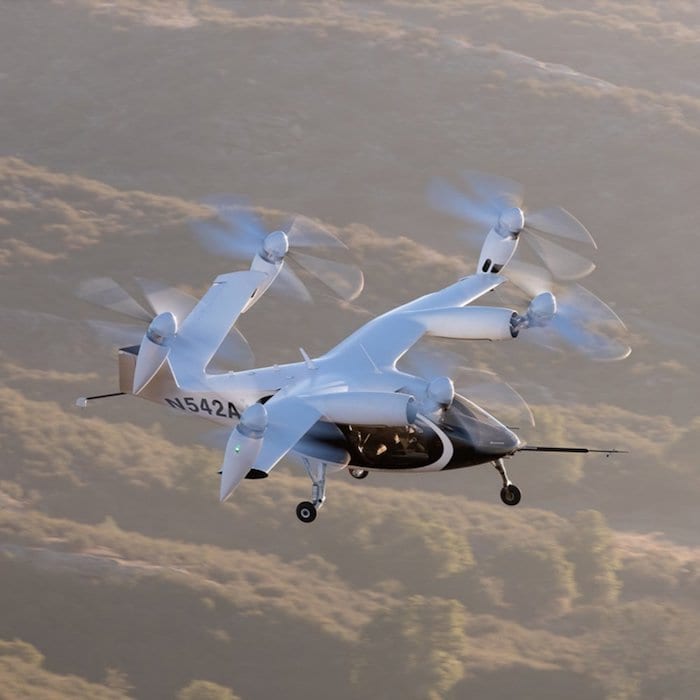
Joby Aviation is developing an electric vertical takeoff and landing (eVTOL) aircraft that the company expects to be ready for commercial service by 2024. During an FIA Connect panel, their leader of policy and government affairs discussed some of their latest plans. (Joby Aviation)
The aviation industry is brimming with sustainability pledges and partnerships all promising to reduce or eliminate carbon emissions by 2050. Industry experts on a panel discussion at the remotely hosted Farnborough International Airshow Connect on July 14, said these promises are more than words and are showing signs of coming to fruition.
“It’s not enough to just say we’re going to be net-zero in 2050, but now we’re saying how are we going to get there in the short term, whether that’s through SAF [sustainable aviation fuels] at 2030 or fuel and fleet improvements over time, there’s a lot that’s out there and I think the level of transparency and commitment across the industry is what really encourages me that this time is different and that this will stick as a priority,” Amelia DeLuca, managing director of sustainability at Delta Air Lines, said.
DeLuca said that one of the short-term commitments for Delta was being carbon neutral.
“This is different, and I can see that across the industry,” DeLuca said. “Just looking within Delta, I think about what we’ve done in the last 18 months and the commitments that we made pre-pandemic that we continue to be committed to today. For example, our commitment to carbon neutrality, which started March of 2020 is something that we have fulfilled and continue to be committed to despite the challenge in our industry.”
Sean Newsum, director of environmental strategy for Boeing, said he is encouraged by the scale of commitment from across the industry.
“I think what’s notable this time is that the breadth of commitment across countries, regions of the world, across the industrial sectors, and their commitments to decarbonization, not just within aviation, but broadly across sectors, that’s very different this time,” Newsum said.
This commitment has also not waned in the face of COVID-19 which had significant impacts across the industry.
“I think it’s really notable that we went through a very significant economic disruption of the airline industry, it’s still reeling from the effects of the pandemic, and yet here we are talking about sustainability and decarbonizing aviation, despite the fact that the effects of the pandemic, the global downturn are still with us,” Newsum said. “So I think if that attention can persist through this kind of disruption to our industry, there’s no reason to think it’s not going to stick around once we fully recover from the pandemic.”
Newsum said the industry now has a realistic vision of what is needed to decarbonize and what solutions could come in the near term versus what solutions may still be farther into the future.
While the industry has parsed which solutions are closer to becoming a reality, DeLuca said that doesn’t mean the more long-term solutions should not receive the same level of support.
“In my opinion, at least from the Delta perspective, there is no one answer and to throw ourselves towards one answer is going to sell ourselves short especially as a global airline like Delta,” DeLuca said. “We fly short-haul, we fly long haul, and so we need to make sure that we have awareness of all of the solutions that are out there and that we as a company are supporting the innovation.”
The developments in the electric aircraft space over the last decade are another reason industry experts are more hopeful for the future of sustainable aviation. Joby Aviation is building an electric vertical takeoff and landing (eVTOL) aircraft that could be launched as soon as 2024. Max Fenkell, policy and government affairs lead at Joby Aviation, said advances in battery technology have allowed the industry to advance in the last two decades.
“I think the advances in the technology now really make platforms like Joby possible and you’re seeing the investments come from both large companies like Boeing, companies like ours, and a whole host of companies in between, as well as some airlines who began to think about it as well,” Fenkell said. “So, what we’re seeing now is that both consumers and countries are demanding it in their policies and in their kind of purchasing habits, as well as what’s possible technology.”
Companies like Joby have had the opportunity to consider sustainability in all aspects of their development, Fenkell said.
“From the Joby perspective, we’re obviously building an all-electric aircraft so we’re kind of starting at that top of net-zero tailpipe emissions,” Fenkell said. “So, from our standpoint, it’s been the ethos of everything we’ve done.”
Fenkell said Joby sees itself as one part of the bigger “sustainable menu of options,” recognizing that electric aircraft is not the only technology that needs investment.
“In our opinion, obviously looking at electric first, we know that we are part of the solution,” Fenkell said. “We’re not the only piece but…prioritizing each of them is really important because if we don’t continue to think about each one of them, one’s going to fall very far behind and then we’re going to have to think and do things after the fact to get that technology back up.”
Newsum said that different technologies will have different markets, uses, and maybe even geographies.
“The all of the above approach, the right technology for the right market for the right geography at right time,” Newsum said. “Part of that is not trying to force-fit a particular technology solution, not trying to make battery the solution for every product in every market in every region of the world. We need to find the right technology, the right place, the right time. Some of these technologies will take a couple of decades to mature to the point that they’re viable in the commercial aviation space.”